Add to bookmarks
Application and types of plastic pipes
To date, plastic pipes have a wide enough scope, they are very in demand for various internal engineering systems, namely sewerage, water supply, heating, ventilation, gas pipeline. A number of properties that favorably distinguish them from other species make these products of plastic practically indispensable. So, unlike metal, they do not undergo corrosion, resistance in time does not increase, and their loss of pressure on friction is 30% less. In addition, such pipes are frost-resistant and retain plasticity at a reduced temperature. They have low weight, good throughput, low thermal conductivity. They also have excellent dielectrics and are easy to assemble. The only downside is the low resistance to crushing.
Manufacture of plastic pipes
Plastics are produced from propylene (PP) or ethylene (PVC, PE) carbons that are part of oil and gas. During processing, these low-molecular substances are amenable to polymerization, resulting in the formation of new substances, the number of bonds between the molecules of which increases. Depending on the type of bond formed (linear or spatial) and on the structure of molecules, the plastic is divided into thermosets and thermosets.
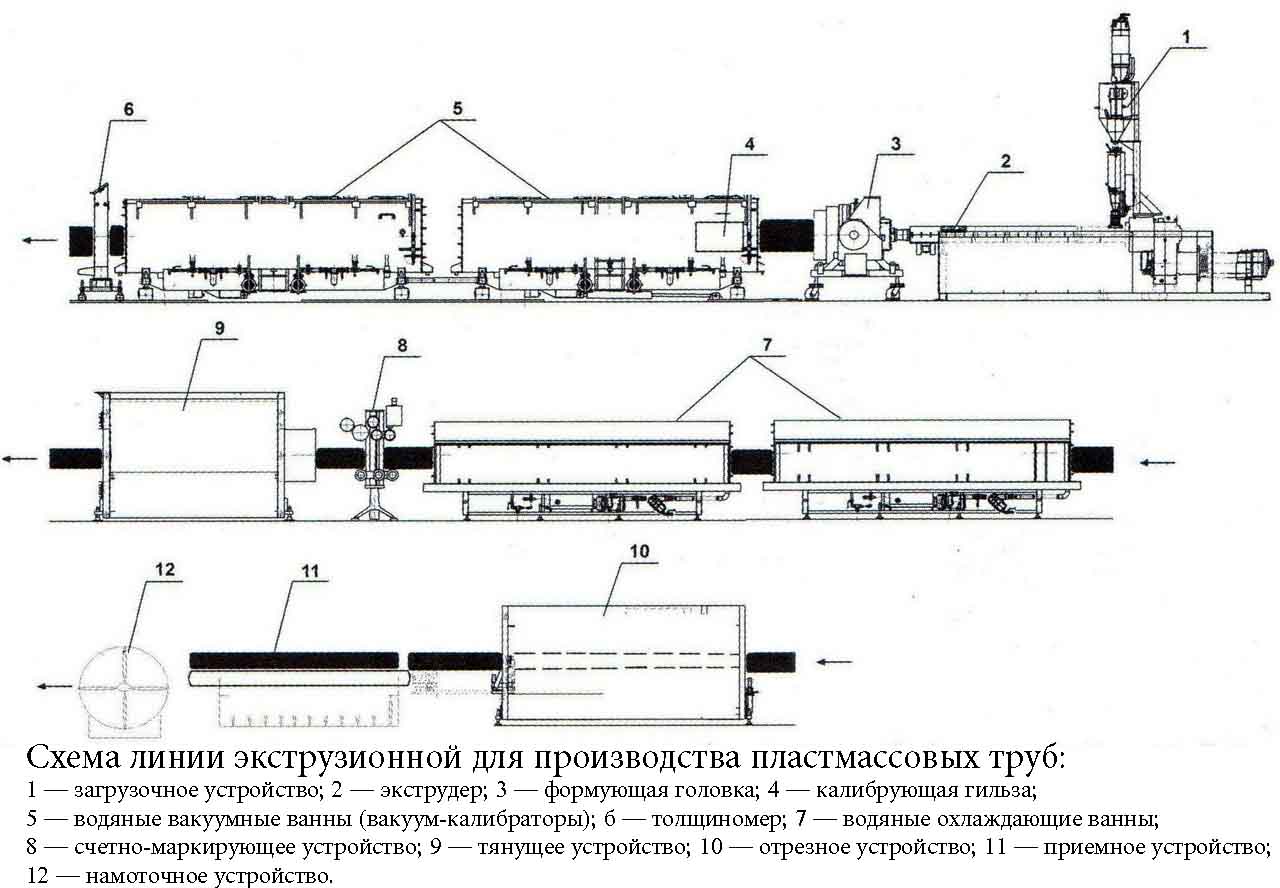
Methods of manufacturing plastic pipes there are several, but the main one is the extrusion method.
Thermoplastics (thermoplastic plastics) are formed from homogeneous linear molecules. When heated, they soften, and upon cooling, the former structure is restored again. Due to the low softening temperature (from + 60 ° C), the application area of the thermoplastic is somewhat limited. Reaktoplasty (thermosetting plastics) differ from the thermoplastic composite composition, they do not have a chemically homogeneous structure, and during processing there is an additional "technological hardening", as a result of which additional three-dimensional bonds are created by the molecules. Reaktoplasty is more resistant to high temperatures, but after exceeding the temperature threshold, they are destroyed. Thermoplasts are also less fragile and retain their internal bonds even when completely melted.
There are several methods of manufacturing plastic pipes, but the main one is the extrusion method. In the first production stage, the plastic in the form of granules is fed to the extruder hopper, after which they are melted and transferred to the extrusion die. The form of the future product is already formed there. This happens under the influence of high internal pressure. In the next step, the workpiece enters the vacuum calibration chamber, where the diameter is calibrated directly and cooling begins. In the next chamber, the pipe is completely cooled, after which it is cut into separate parts. The production process at all stages is monitored by a logical controller responsible for manufacturing high-quality products.
Plastic pipes and their types
For the manufacture of plastic pipes, materials such as polyvinylchloride, polypropylene, polyethylene are most often used.
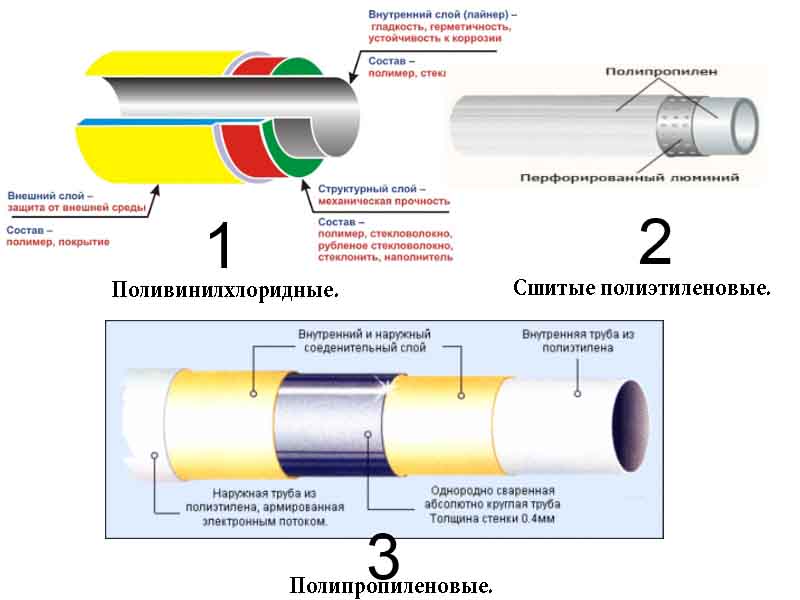
The scheme of the structure of layers of plastic pipes
The most popular are plastic pipes made of polyvinylchloride (PVC). They are able to keep the shape at relatively high heating (+ 80-85 ° C), easily weldable, can dissolve in some solvents, have the lowest coefficient of linear expansion at operating temperature + 60 ° C. They are used in sewerage and water supply systems, in food industry and other technological systems. Installation of PVC pipes is usually carried out by cold welding. They are laid out both in an external and hidden way.
Pipes made of polypropylene (PP) are used for the construction of pipelines for hot and cold water supply, as well as for installing air ducts. They can function at a working fluid temperature of up to + 95 ° C for several decades. Their installation is carried out by diffusion welding, which can be done in just a few minutes, and the design itself has a high seal.

Example of the use of plastic pipes in the plant irrigation system
Polyethylene (PE) pipes are suitable for use at low temperature. They are often used in the creation of external pipelines intended for transportation of drinking and household water, and in addition, a variety of gaseous and liquid substances that do not cause chemical reactions in contact with polyethylene. PE retains its characteristics even at a temperature of -20 ° C, but it should be remembered that the temperature of the transported substances should not exceed +40 ° C., having a diameter of less than 63 mm, is carried out using electrically welded couplings, polypropylene and c. Pipes with a diameter exceeding 63 mm are connected by the butt-welding method, and pipes made of cross-linked polyethylene by the method of permanent jointing or cold pressing, as it is also called.
Quite often used metal-plastic pipes, differing from other species by its three-layer construction. Between the two layers of plastic is a layer of aluminum foil. It serves as a protection from penetration of oxygen and is necessary to reduce the parameters of thermal linear expansion. is carried out due to compression and press fittings. Such pipes are applicable in pressure and heating systems, since they can be operated at a working medium temperature of up to 95 ° C.

Compared with steel, cast iron and copper pipes, polymer pipes pollute the atmosphere very little during production, require a relatively small amount of electricity, while laying in the ground almost do not pollute the soil.
Application of plastic pipes for sewerage
Due to objective reasons, many types of pipes today are laid out of plastic, rather than metal. Steel is not an exception and sewer. Plastic pipe from PVC due to its resistance to the corrosive effects of substances in the drainage waters, has long consolidated its leadership position in this direction. Among other things, such sewerage is easy to operate, it can easily be disassembled and clean the clogged pipe. And to avoid clogging, leakage and depressurization, you need to choose perfectly smooth products, without burrs, blisters and cracks. Otherwise, it will be possible to face many unpleasant consequences in the course of operation.
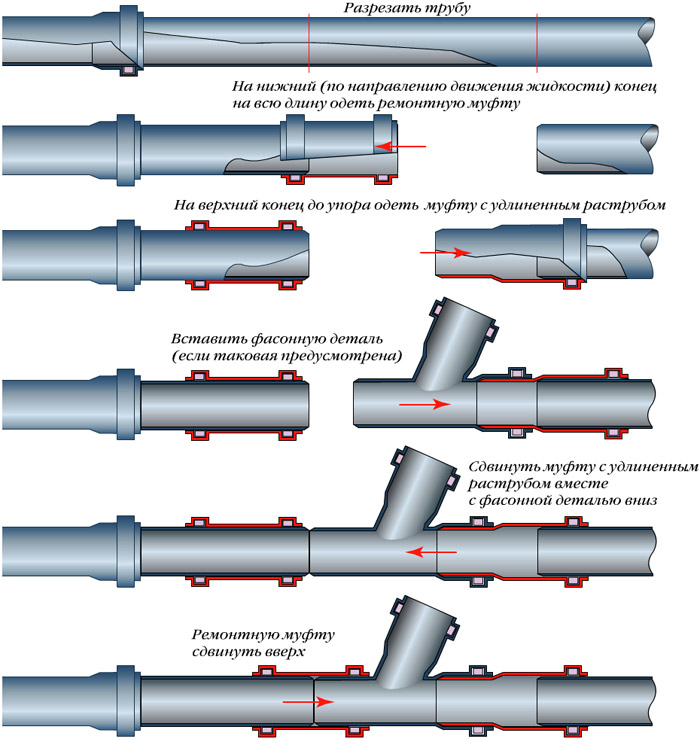
The installation of plastic pipes is quite simple. You just need to insert one tube into the socket of the other, where there is a rubber sealing ring, allowing them to connect without leaks.
Sewer pipes have a different diameter, which should be chosen based on the load. It can be high and low. For example, for apartment buildings, cottages, public facilities recommended to choose a large diameter, designed for increased load. In hotels, hospitals, educational institutions, pipes with a diameter of 200 mm are used, at industrial enterprises - 300 mm. If large loads are not provided for sewage, it will be sufficient to have a diameter of 50 mm.
The installation of plastic pipes is quite simple. You just need to insert one tube into the socket of the other, where there is a rubber sealing ring, allowing them to connect without leaks. You do not need to cover anything, mint. If the pipe does not enter the bell, you can warm up its end over the lamp or plate hob. It is important not to overheat and melt the plastic, otherwise the pipe will simply become unusable.
In apartments the plastic pipe is usually mounted in this order:
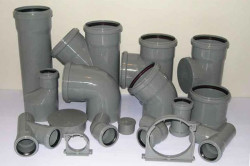
For general sewerage (faeces and water) at the optimum flow rate (from 0.7 to 1 m / s) the slope is made at the rate of 1-2 cm per m.
- siphon under the sink in the kitchen;
- branch (knee) - a short pipe bent at an angle of 90 °;
- pipe diameter of 50 mm;
- Y-fitting (oblique tee) for connecting the bath;
- again a pipe with a diameter of 50 mm;
- T-fitting (straight tee) for connecting the washbasin;
- pipe 50 mm in diameter, leading up to the entrance to the sewer riser.
When laying the sewage system for private houses, two factors must be taken into account: slope and depth. The slope will depend on the ability of the pipeline to self-clean and the flow rate. For the general sewerage (faeces and water) at the optimum flow rate (from 0.7 to 1 m / s), the slope is made at the rate of 1-2 cm per m. The recommended depth is 70-90 cm at the house, followed by a deepening along the slope, not less than 1 m to the outlet.
Plumbing from plastic pipes
Plastic pipelines are often used for installation of water pipes. The pipes involved in this can be of different types, namely:
- Polyethylene (PE), withstanding operating pressure from 6 to 10 kgf / cm 2 and having the lowest operating temperature (-20 ° C). They are suitable for both indoor and outdoor water supply.
- Cross-linked polyethylene (PEH), which have higher strength and improved temperature characteristics.
- Pipes made of polyvinylchloride (PVC), having high operational properties and a fairly low cost.
- Metal-plastic pipes (PEH-AL-PEH), capable of withstanding pressure up to 10 bar, and their operating temperature is + 95 ° C.

Trenchless laying of plastic pipes for water supply
The main thing when installing plastic pipes is to use short nodes with high rigidity as little as possible, leaving the system as flexible as possible. The minimum number of connections reduces the risk of leakage. Mount the plastic piping to the walls and ceiling is with the help of mobile supports. When they are connected to metal parts, it is necessary to use combined split fittings with metal inserts. On the straight section of the water pipe, more than 3 m in length, it is necessary to install ring compensators, ready-made or welded. If it occurs in the ground, it is important to avoid mechanical stress on them.
At the initial stage of installation, measure and cut off a part of the pipe of the required length, and peel off the butt from the burrs and crumbs. Then mark the depth of the inlet fitting, while not allowing the fitting to move to the stop. In order to avoid distortion, at the junctions of the pipe and fitting, labels are also applied, after which they are put on the heated nozzle of the soldering iron. It is important that both parts are heated simultaneously, and fit as tightly as possible, without turning along the center line. Trub will need 20-30 seconds to fully freeze. The same scheme connects the other constituent elements.
Heating, gas pipeline and ventilation
For a heating system, plastic pipes are chosen for a variety of reasons. First, they serve up to 50 years and can not be corroded. Secondly, due to their smooth internal surface, they do not produce noise during the flow of water through them. In addition, they do not form calcareous deposits. Also plastic pipes have a low thermal conductivity, the water in them cools much more slowly than in metal ones. And they are resistant to pressure and temperature changes.
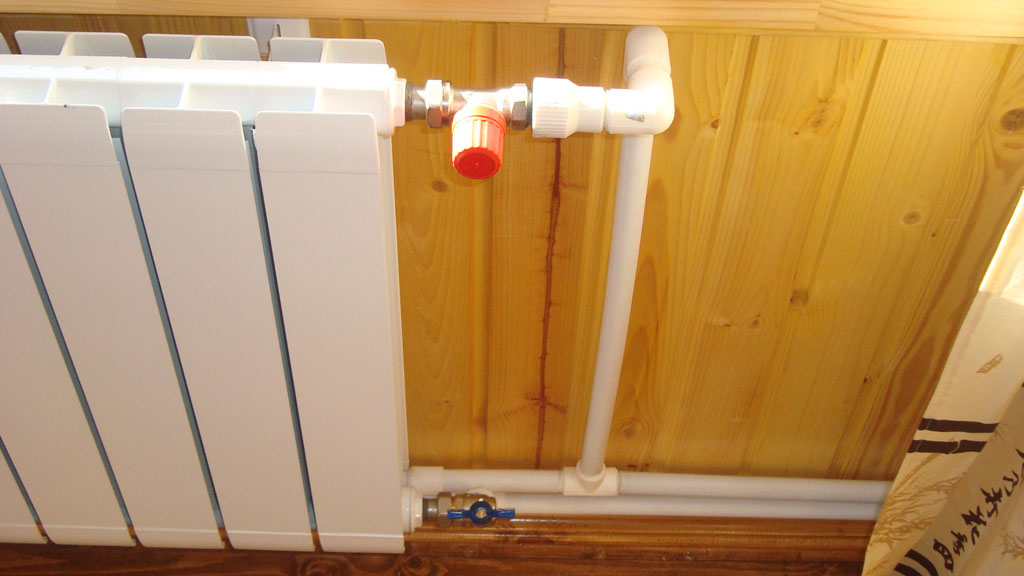
For the heating system suitable metal-plastic pipes, PVC, polyethylene and polypropylene.
For the heating system suitable metal-plastic pipes, PVC, polyethylene and polypropylene. It should be noted that the latter are slightly different from all other types of plastic pipes. So, over time, they can change their shape, because they have high fluidity. And they are deformed even under the influence of their own weight, so you need to increase the number of fasteners or use them only for internal wiring.
As in a number of other cases, they are connected without welding, but only by soldering or fittings. In the case of installing a concealed heating system with use, attention should be paid to the fact that the linear expansion of a pipe section, whose length is 5 m, is 4-5 mm. To avoid damaging the finish of the walls, sufficient number compensators on the pipeline.
If only pipes made of steel were used for laying the gas pipeline 10 years ago, today polyethylene ones are used. They have high resistance to the negative effects of environmental factors and various chemical compounds. The ductility of such pipes is combined with strength, which makes their laying convenient and possible even in regions with harsh climatic conditions. Plastic pipes do not require additional protection before their laying in the ground, because they are already protected from electrochemical damage.
It is necessary to know that plastic pipes are used only for underground installation, and the entry into the house and the distribution of the gas pipeline directly inside the premises is carried out only by steel. In addition, use is prohibited in areas where the air temperature drops to -45 ° C, and seismicity exceeds 6 points. They can not be built inside buildings, in an urban area for transporting high-pressure gas (I and II categories).
Another area of application of plastic pipes is ventilation. This is due to the fact that they provide high reliability of engineering systems and guarantee a high service life. For installation next to the ventilation outlet, a pipe is installed, from which other pipes extend, with a diameter of 160 mm. Sometimes, in order to avoid the appearance of unpleasant smells, plastic pipes are equipped with additional fans, which ensure the maximum speed of air transport. It is advisable to use plastic ventilation pipelines in places of large population, for example, in cafes, restaurants, gyms, fitness clubs.
- Manufacture of plastic pipes
- Plastic pipes and their types
- Application of plastic pipes for sewerage
- Plumbing from plastic pipes
- Heating, gas pipeline and ventilation
To date, plastic pipes have a wide enough scope, they are very in demand for various internal engineering systems, namely sewerage, water supply, heating, ventilation, gas pipeline. A number of properties that favorably distinguish them from other species make these products of plastic practically indispensable. So, unlike metal, they do not undergo corrosion, resistance in time does not increase, and their loss of pressure on friction is 30% less. In addition, such pipes are frost-resistant and retain plasticity at a reduced temperature. They have low weight, good throughput, low thermal conductivity. They also have excellent dielectrics and are easy to assemble. The only downside is the low resistance to crushing.
Plastic pipes are frost-resistant and retain plasticity at a reduced temperature.
Manufacture of plastic pipes
Plastics are produced from propylene (PP) or ethylene (PVC, PE) carbons that are part of oil and gas. During processing, these low-molecular substances are amenable to polymerization, resulting in the formation of new substances, the number of bonds between the molecules of which increases. Depending on the type of bond formed (linear or spatial) and on the structure of molecules, the plastic is divided into thermosets and thermosets.
There are several methods of manufacturing plastic pipes, but the main one is the extrusion method.
Thermoplastics (thermoplastic plastics) are formed from homogeneous linear molecules. When heated, they soften, and upon cooling, the former structure is restored again. Due to the low softening temperature (from + 60 ° C), the application area of the thermoplastic is somewhat limited. Reaktoplasty (thermosetting plastics) differ from the thermoplastic composite composition, they do not have a chemically homogeneous structure, and during processing there is an additional "technological hardening", as a result of which additional three-dimensional bonds are created by the molecules. Reaktoplasty is more resistant to high temperatures, but after exceeding the temperature threshold, they are destroyed. Thermoplasts are also less fragile and retain their internal bonds even when completely melted.
There are several methods of manufacturing plastic pipes, but the main one is the extrusion method. In the first production stage, the plastic in the form of granules is fed to the extruder hopper, after which they are melted and transferred to the extrusion die. The form of the future product is already formed there. This happens under the influence of high internal pressure. In the next step, the workpiece enters the vacuum calibration chamber, where the diameter is calibrated directly and cooling begins. In the next chamber, the pipe is completely cooled, after which it is cut into separate parts. The production process at all stages is monitored by a logical controller responsible for manufacturing high-quality products.
LTD DESIGN PRESTIGE
Plastic pipes and their types
For the manufacture of plastic pipes, materials such as polyvinylchloride, polypropylene, polyethylene are most often used.
The scheme of the structure of layers of plastic pipes
The most popular are plastic pipes made of polyvinylchloride (PVC). They are able to keep the shape at relatively high heating (+ 80-85 ° C), easily weldable, can dissolve in some solvents, have the lowest coefficient of linear expansion at operating temperature + 60 ° C. They are used in sewerage and water supply systems, in food industry and other technological systems. Installation of PVC pipes is usually carried out by cold welding. They are laid out both in an external and hidden way.
Pipes made of polypropylene (PP) are used for the construction of pipelines for hot and cold water supply, as well as for installing air ducts. They can function at a working fluid temperature of up to + 95 ° C for several decades. Their installation is carried out by diffusion welding, which can be done in just a few minutes, and the design itself has a high seal.
Example of the use of plastic pipes in the plant irrigation system
Polyethylene (PE) pipes are suitable for use at low temperature. They are often used in the creation of external pipelines intended for transportation of drinking and household water, and in addition, a variety of gaseous and liquid substances that do not cause chemical reactions in contact with polyethylene. PE retains its characteristics even at -20 ° C, but it should be remembered that the temperature of the transported substances should not exceed +40 ° C. The connection of polyethylene pipes having a diameter of less than 63 mm is carried out by means of electrically welded couplings, polypropylene and brass fittings with sealing rings. Pipes with a diameter exceeding 63 mm are connected by the butt-welding method, and pipes made of cross-linked polyethylene by the method of permanent jointing or cold pressing, as it is also called.
Metal-plastic pipes, which differ from other types with their three-layer construction, are often used. Between the two layers of plastic is a layer of aluminum foil. It serves as a protection from penetration of oxygen and is necessary to reduce the parameters of thermal linear expansion. Installation of metal-plastic pipes is carried out due to compression and press fittings. Such pipes are applicable in pressure and heating systems, since they can be operated at a working medium temperature of up to 95 ° C.
Compared with steel, cast iron and copper pipes, polymer pipes pollute the atmosphere very little during production, require a relatively small amount of electricity, while laying in the ground almost do not pollute the soil.
LTD DESIGN PRESTIGE
Application of plastic pipes for sewerage
Due to objective reasons, many types of pipes today are laid out of plastic, rather than metal. Steel is not an exception and sewer. Plastic pipe from PVC due to its resistance to the corrosive effects of substances in the drainage waters, has long consolidated its leadership position in this direction. Among other things, such sewerage is easy to operate, it can easily be disassembled and clean the clogged pipe. And to avoid clogging, leakage and depressurization, you need to choose perfectly smooth products, without burrs, blisters and cracks. Otherwise, it will be possible to face many unpleasant consequences in the course of operation.
The installation of plastic pipes is quite simple. You just need to insert one tube into the socket of the other, where there is a rubber sealing ring, allowing them to connect without leaks.
Sewer pipes have a different diameter, which should be chosen based on the load. It can be high and low. For example, for multi-family houses, cottages, public facilities, it is recommended to choose a large diameter, designed for increased load. In hotels, hospitals, educational institutions, pipes with a diameter of 200 mm are used, at industrial enterprises - 300 mm. If large loads are not provided for sewerage, a diameter of 50 mm will suffice.
The installation of plastic pipes is quite simple. You just need to insert one tube into the socket of the other, where there is a rubber sealing ring, allowing them to connect without leaks. You do not need to cover anything, mint. If the pipe does not enter the bell, you can warm up its end over the lamp or plate hob. It is important not to overheat and melt the plastic, otherwise the pipe will simply become unusable.
In apartments the plastic pipe is usually mounted in this order:
For general sewerage (faeces and water) at the optimum flow rate (from 0.7 to 1 m / s) the slope is made at the rate of 1-2 cm per m.
- siphon under the sink in the kitchen;
- branch (knee) - a short pipe bent at an angle of 90 °;
- pipe diameter of 50 mm;
- Y-fitting (oblique tee) for connecting the bath;
- again a pipe with a diameter of 50 mm;
- T-fitting (straight tee) for connecting the washbasin;
- pipe 50 mm in diameter, leading up to the entrance to the sewer riser.
When laying the sewage system for private houses, two factors must be taken into account: slope and depth. The slope will depend on the ability of the pipeline to self-clean and the flow rate. For the general sewerage (faeces and water) at the optimum flow rate (from 0.7 to 1 m / s), the slope is made at the rate of 1-2 cm per m. The recommended depth is 70-90 cm at the house, followed by a deepening along the slope, not less than 1 m to the outlet.
LTD DESIGN PRESTIGE
Plumbing from plastic pipes
Plastic pipelines are often used for installation of water pipes. The pipes involved in this can be of different types, namely:
Trenchless laying of plastic pipes for water supply
The main thing when installing plastic pipes is to use short nodes with high rigidity as little as possible, leaving the system as flexible as possible. The minimum number of connections reduces the risk of leakage. Mount the plastic piping to the walls and ceiling is with the help of mobile supports. When they are connected to metal parts, it is necessary to use combined split fittings with metal inserts. On the straight section of the water pipe, more than 3 m in length, it is necessary to install ring compensators, ready-made or welded. If there is a laying of pipes in the ground, it is important to avoid mechanical impact on them.
At the initial stage of installation, measure and cut off a part of the pipe of the required length, and peel off the butt from the burrs and crumbs. Then mark the depth of the inlet fitting, while not allowing the fitting to move to the stop. In order to avoid distortion, at the junctions of the pipe and fitting, labels are also applied, after which they are put on the heated nozzle of the soldering iron. It is important that both parts are heated simultaneously, and fit as tightly as possible, without turning along the center line. Trub will need 20-30 seconds to fully freeze. The same scheme connects the other constituent elements.
LTD DESIGN PRESTIGE
Heating, gas pipeline and ventilation
For a heating system, plastic pipes are chosen for a variety of reasons. First, they serve up to 50 years and can not be corroded. Secondly, due to their smooth internal surface, they do not produce noise during the flow of water through them. In addition, they do not form calcareous deposits. Also plastic pipes have a low thermal conductivity, the water in them cools much more slowly than in metal ones. And they are resistant to pressure and temperature changes.
For the heating system suitable metal-plastic pipes, PVC, polyethylene and polypropylene.
For the heating system suitable metal-plastic pipes, PVC, polyethylene and polypropylene. It should be noted that the latter are slightly different from all other types of plastic pipes. So, over time, they can change their shape, because they have high fluidity. And they are deformed even under the influence of their own weight, so you need to increase the number of fasteners or use them only for internal wiring.
As in a number of other cases, plastic heating pipes are connected without welding, but only by soldering or fittings. If a concealed heating system is installed using polypropylene pipes it is necessary to pay attention to the fact that the linear expansion of the pipe section, whose length is 5 m, is 4-5 mm. In order not to damage the wall decoration, it is necessary to install a sufficient number of expansion joints on the pipeline.
If only pipes made of steel were used for laying the gas pipeline 10 years ago, today polyethylene ones are used. They have high resistance to the negative effects of environmental factors and various chemical compounds. The ductility of such pipes is combined with strength, which makes their laying convenient and possible even in regions with harsh climatic conditions. Plastic pipes do not require additional protection before their laying in the ground, because they are already protected from electrochemical damage.
It is necessary to know that plastic pipes are used only for underground installation, and the entry into the house and the distribution of the gas pipeline directly inside the premises is carried out only by steel. In addition, the use of polyethylene pipes for gas pipelines is prohibited in areas where the air temperature drops to -45 ° C, and seismicity exceeds 6 points. They can not be built inside buildings, in an urban area for transporting high-pressure gas (I and II categories).
Another area of application of plastic pipes is ventilation. This is due to the fact that they provide high reliability of engineering systems and guarantee a high service life. For installation next to the ventilation outlet, a pipe is installed, from which other pipes extend, with a diameter of 160 mm. Sometimes, in order to avoid the appearance of unpleasant smells, plastic pipes are equipped with additional fans, which ensure the maximum speed of air transport. It is advisable to use plastic ventilation pipelines in places of large population, for example, in cafes, restaurants, gyms, fitness clubs.
Plastic pipes are now widely used. In comparison with metal they have both a number of advantages and disadvantages.
Consider them all in order. Benefits:
- Easy to install. The connection of plastic pipes does not require welding machine and the skills of a high-quality welder who knows how to make sealed seams. Some types of such pipes are connected by means of special couplings with rubber sealing rings. Others - with the help of special instruments by heating. To master this technology is easy even for a person far from the skills of a welder and plumber.
- Durability. The service life of plastic pipes exceeds 50 years, which is much more than steel.
- Not susceptible to corrosion. Due to this, fistulas and ruptures caused by rust do not appear in them.
- Ecological compatibility. Plastic pipes do not harm the environment and are harmless to humans.
- Functionality. The ability to use them for a variety of needs due to their physical qualities - lightness and flexibility.
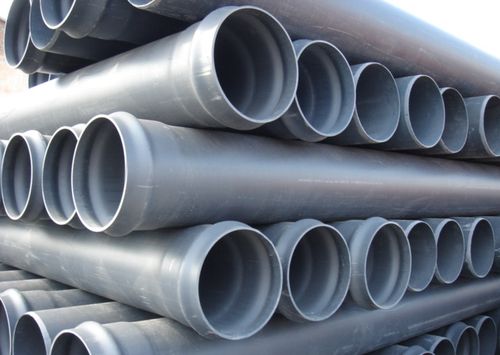
Disadvantages:
- Limited use. Not every plastic pipe can be used to feed hot water or for an emergency fire extinguishing system.
- Friability. Less resistance to shock, pressure and other mechanical loads.
As you can see from the above, plastic pipes have much more advantages over metallic ones, rather than disadvantages. This was the reason for their wide application in all sectors of the national economy - from construction and industry to agriculture.
All plastic pipes differ from each other. First of all, the material from which they are made.
Polypropylene
This material has the property of retaining the original shape with a fairly strong heating - up to +85 degrees Celsius. The assembly of plastic pipes from polypropylene can be carried out both by heating (this material is easily melted and has good adhesion) and "cold welding". In addition, for sewerage, where there is no constant internal pressure, the method of connection using couplings and fittings equipped with rubber rings is applied.
Polypropylene systems are used for water supply, sewerage, food and industrial industries. This polymer is the cheapest - sometimes at times cheaper than other plastics. This factor causes its wide application in many areas. In this case, polypropylene pipes can be executed in several versions - single-layer, multi-layer (includes internal reinforcing layers), coal and fiberglass. Diameters of polypropylene pipes according to GOST are from 1.6 to 12.5 cm.
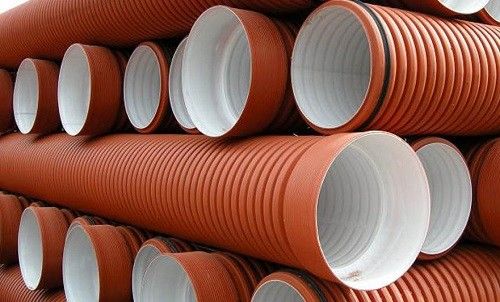
Polyethylene
Systems of this material are used for laying pipelines, both external and inside buildings. The main advantage of polyethylene pipes is their resistance to low temperatures. So, it is allowed to perform works on their installation at a temperature of -20 degrees. Polyethylene pipes up to 60 mm in diameter are connected by means of fittings with rubber seals, and wider ones by welding.
Available in two versions - for high and low pressure, and are used for water and sewerage. Polyethylene is made and pipes large diameter.
Crosslinked polyethylene
Crosslinking is carried out as follows: the pipe is melted under a certain pressure, as a result of which strong bonds are formed between the polymer molecules. This polyethylene is durable and resistant to physical influences. But it has its own minus - it can not be combined with an iron.
For joining a cross-linked polyethylene, only cold methods are allowed. These pipes are used mainly for hot and cold water supply, laying lines of emergency fire extinguishing.

Metal Polymers
This material appeared on our market relatively recently and is a product of "high technologies". In its essence, it is the same cross-linked polyethylene, reinforced from the inside with metal. In the section it represents a layered pie: first comes a layer of polyethylene, then a glue on which a thick aluminum foil or sheet is attached. On top again covered with a layer of glue and again filled with polyethylene.
The plus of these pipes is that they keep their shape when bent. Diameters of plastic pipes from metal polymers are from 1.6 to 30 cm and more. Of metal-plastic are manufactured and profile pipes of square section.
Consider in which areas plastic pipes are used. They are mainly used for the installation of water supply, sewerage and gas (ventilation).
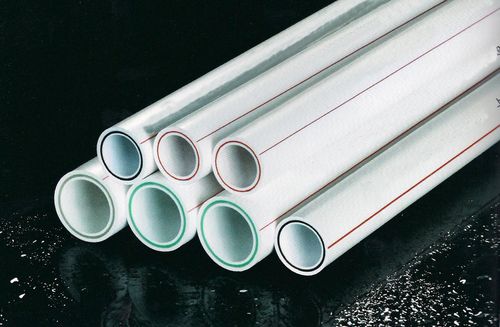
Water pipes
This is the main field of application of pipes made of polymers. This is due to the resistance of the plastic to water - it is not susceptible to rust. Also plastic has a 30% less resistance to the current of water than metal. The main thing when installing systems from plastic pipes is compliance with technology.
It is recommended to make as few joints as possible, this guarantees greater reliability of the entire system. On the straight sections, it is necessary to install compensating rings. Due to the fact that plastic is a rather brittle material, in comparison with metal, it is necessary to avoid exerting excessive mechanical influence on it.
For heating choose metal-plastic pipes and polyethylene. It is also possible to use polypropylene, but it should be borne in mind that they can become deformed even under their own weight when heated. Therefore, in this case, it is necessary to provide as many supporting fasteners as possible.
Sewerage
For these purposes, the most suitable products from polyvinyl chloride - they are most resistant to aggressive environments of sewage. They do not form salt deposits and traces of corrosion. Select sewer pipes by diameter in accordance with the expected load on them. The installation of plastic pipes equipped with special extensions is extremely simple - you just need to insert one end of the pipe into the other, equipped with an expansion (bell).
When installing the sewage system, the necessary slope should be observed so that drains do not accumulate inside the pipes. The recommended bias is 3: 100, that is, three centimeters per meter. When using PVC pipes for laying street sewage, it is necessary to deepen them not less than a meter, and also insulate glass wool, mineral mats, etc.
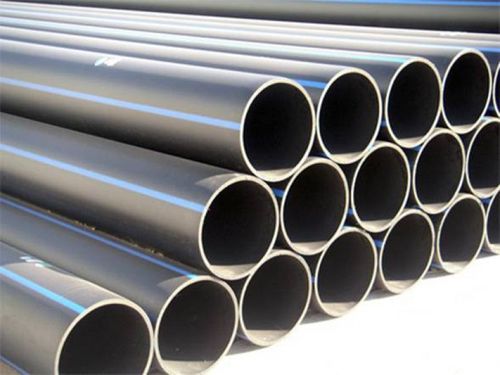
Gas pipeline and ventilation
For the construction of gas pipelines tens of years ago only metal pipes were used. But in recent years for these purposes, more actively use plastic, most often polyethylene. However, due to their susceptibility to mechanical damage, such pipes are laid exclusively underground.
Entry into the house and internal wiring is performed exclusively by metal pipes. Also, the SNiP prohibits the use of plastic pipes in the areas of the extreme north and seismically active zones in the construction of gas pipelines. For ventilation in recent years also actively began to use plastic. Profile pipes of plastic rectangular and square section are much cheaper than galvanized or stainless steel.
They meet all the safety requirements, they are durable, they allow to reduce construction and maintenance costs of buildings. On the market today it is possible to purchase pipes of foreign and domestic production, while high-quality products are produced both abroad and in our country. Imports mostly come from Turkey, Germany, the Czech Republic and China, the price for the most part does not exceed the cost of Russian analogs, however, the quality too.
Plastic: the pros and cons
What features are inherent in all, without exception, pipes made of plastic? It:
- durability (service life of such pipes is more than 50 years),
- resistance to rust,
- low thermal conductivity,
- light weight,
- Ecological cleanliness and low noise.
Gray polypropylene on the market is represented by Chinese models, reinforced with Russian brands, and white plastic is diverse both in the price range and in the technical.
Of course, plastic pipes have drawbacks:
- Firstly, in hot systems heating systems they can be mounted is limited, and for systems of a fire-prevention waterpipe they at all do not approach,
- Secondly, each type of polymer has its own installation features, which means that masters have specialization and their services stand somewhat more expensive.
Types of plastic pipes
In the construction and finishing materials You can buy plastic pipes of several types:
- polypropylene (PP) pipes,
- pipes made of polyvinylchloride (PVC),
- polyethylene pipes (PE),
- pipes made of cross-linked polyethylene (PEH),
- metal-plastic constructions (PEX-AL-PEX),
PVC pipes have been used for a long time, polyvinyl chloride has been used to produce pipes as one of the first materials. Polyvinyl chloride used in production is environmentally friendly, SNiP is recommended, pipes from it can be used in food industry, in systems of hot and cold water cold water supply, with the device sewage systems.
PVC pipes are easy to use, no special tools and special skills are required for installation. Pipe joining is a simple method of docking using " cold welding ", connect them and into the socket, using a rubber cuff. It should be remembered about the rigidity of pipes, it is necessary to attend to the presence of fittings for the connection. Pipes made of PVC can be laid either directly or externally, and in any case the cost of the pipeline using such materials will be low.
Polypropylene pipes can be single-layered and multilayered, while multilayer pipes are subdivided, in turn, into three subtypes:
- the foil is strengthened over the working layer, fixed to the glue, covered with propylene,
- a pipe, a foil and a protective layer are connected by the perforated apertures,
- puffed design , in which non-plastic polypropylene is located between two layers of the base material.
Polypropylene products are very light, so even a large diameter pipe can be installed by a couple of people. Compared with polyethylene analogues, PE pipes have significantly higher heat resistance values, they can be used at a drain temperature of 80 ° C. At low temperatures they do not lose elasticity, and therefore their often use for laying the outside water supply, besides the cross-section of the pipes does not decrease due to overgrowing and deposits.
Such pipes are equipped with fittings with thread, which makes it possible to mount them in ready-made systems pipelines.
Polyethylene pipes are also designed for indoor and outdoor water pipes (water supply systems, sewage systems, drains, etc.), but polyethylene has the lowest minimum temperature among analogues - up to -20 ° C. This parameter is important to take into account where the pipes are to be installed in the cold season.
Cross-linked polyethylene lacks the disadvantages of simple polyethylene, in particular, it is resistant to temperature changes. The process of "stitching" has nothing to do with the mechanical effect on pipe , we are talking about the process of manufacturing polyethylene itself, the material is processed by special technology during manufacturing, so that additional bonds are formed between the molecules, "crosslinks". This makes polyethylene pipes durable, reliable and durable, however, during installation it is important to prevent the entry of free oxygen into the water supply system - this is done using a diffuse barrier that covers the pipes.
Pipes made of polymers (metal plastic pipes) can be called the youngest in the market - the process of their production was launched only about 10 years ago. The pipes are able to keep their shape when bending, they withstand large temperature loads and are able to work under pressure up to 10 bar. Pipes are resistant to wear, have minimal thermal expansion and are impermeable to gases - all thanks to the foil layer located inside the pipe.
Regardless of the type, plastic pipes allow to lay durable, economical and safe systems of water supply, sewerage, drains, taking into account all modern requirements to engineering systems.
We have considered. They found out what they are and estimated the main advantages and disadvantages of these or those types of metal pipes. And today, as I promised, we'll talk about plastic (polymer) pipes. Hello.
Polymer pipes made of polyethylene (PE), polyvinyl chloride (PVC) and polypropylene (PP), etc. have been widely used in sewerage and water supply systems recently. First, let's see what is characteristic of all plastic pipes and highlight their main advantages and disadvantages .
Common advantages of plastic pipes:
Strength;
Durability;
Plasticity and ability to stretch up to 7% while maintaining their qualities;
Excellent dielectric properties (protection from stray currents is not required);
Low thermal conductivity;
Resistance to corrosion;
Slight friction losses (small surface roughness);
Absence of bacteria, decay, decay, calcareous deposits on the walls;
Good sound insulation properties (low noise level);
Easy transport (light weight);
Ease of installation.
Common disadvantages:
Inability to fire water supply systems;
Loss of strength from time and loads;
Do not tolerate visible sunlight;
For various types of plastic pipes, certain assembly and welding devices are required;
Oxygen permeability.
I think we need to clarify what is oxygen permeability. The term seems to be understandable, but still. Under oxygen permeability in this case we mean the diffusion through the walls of a pipe of a small amount of oxygen contained in the air. And what's wrong with that, you say? In the case of a pipeline to feed water to the tap, it's okay that there's a piece of oxygen in the water, no. But in the case if we are dealing with a coolant (antifreeze, water), then the oxygen that gets into it will disable either the boiler or heating appliances, which is not gud. That is, in this case, such pipes will not work for us.
At present, pipes of polyethylene, cross-linked polyethylene, polyvinyl chloride, polypropylene, polybutene and fiberglass are widely represented on the market of plastic pipes.
The service life of plastic pipes is at least 50 years.
Polyethylene pipes (PE or PE)
Pluses:
Low cost;
Light weight;
Ease of installation;
Low thermal conductivity;
Resistance to the effects of various chemical compounds.
Disadvantages:
Flexibility is lower than that of other polymers.
Pipes made of polyethylene are used for internal and external pressure pipelines (sewerage, water supply, drains).
There are 2 types of polyethylene:
1) high pressure polyethylene LDPE (or LDPE - low density polyethylene);
2) low density polyethylene HDPE (or PVP - high density polyethylene).
Pipes made of PVD have less mechanical strength than HDPE pipes, so they have thicker walls and a correspondingly larger mass. This gives a certain advantage to the LDPE pipes: they absorb the noise of the medium transported much better.
Pipes from PVP are widely used for cold water supply systems. These pipes are characterized by very high strength. Frozen inside a high-density polyethylene pipe, water will not damage it, and the pipe, when thawed, will perfectly maintain its operational properties.
Pipes made of cross-linked polyethylene
As a result of various types of processing of polyethylene in order to give it additional strength and resistance to temperature effects between its molecules, cross bonds (the so-called stitching, or bridges). The processing process is called cross-linking, and the material formed after such processing is cross-linked with polyethylene. Cross-linked polyethylene has a characteristic labeling - PE-X (PE-C). There are four types of PE-X, depending on the type of crosslinking: PE-Xa, PE-Xb, PE-Xc and PE-Xd. They differ in the proportion of crosslinked molecules and, consequently, strength. So, of all the above varieties, cross-linked polyethylene with the abbreviation RE-XA has the highest percentage of cross-linking.
Due to high oxygen permeability, XLPE pipes are mainly used for hot and cold water supply. For warm floors and heating systems, pipes with an internal or external diffusion barrier, preventing the penetration of oxygen, are specially designed. The inner barrier is achieved with ethylene vinyl alcohol, and the outer barrier is achieved using an aluminum foil layer having a thickness of 0.1 to 0.15 mm. In addition, due to the use of aluminum foil, a significant reduction in the value of thermal expansion is achieved (these pipes are also called stabilized ).
For the installation of PE-X pipelines, mechanical connectors are used in the form of threaded and press fittings, as well as clamping sleeves of various designs. The installation of RE-X pipes with threaded fittings, in my opinion, is akin to masochism in its pure form: first, it is quite laborious, and secondly, it requires maintenance and control in the process of operation. The tightening of the crimp nuts gradually weakens, which can lead to depressurization of the joint.
Diameters of PE-X pipes presented in the modern market have a small range - 12-32 mm. This is a functional and economic explanation: with a larger diameter, accordingly, a greater wall thickness will also result, resulting in a decrease in the elasticity of such pipes, and the connectors for such pipes will cost considerably more. Do we need it?
Polypropylene pipes (PP or PP)
Polypropylene pipes are rapidly gaining ground on russian market. Pressure polypropylene pipes are produced with a diameter of 16 - 250 mm and are used for cold, hot water, heating and sewage systems. Polypropylene pipes and fittings are connected by the method of high-temperature socket fusion.
Like PE-X pipes, PP pipes are presented in the market in the form of both single-layer and multi-layer structures (with a layer of fibrous plastic or aluminum foil). Multilayer pipes are called stabilized. In their labeling there is either the word "stability" or its derivatives. Such pipes less oxygen and have greater stability of shape (have a smaller linear expansion).
Pluses:
Pipes made of polypropylene are hygienic, non-toxic and do not impart foreign smells and tastes to drinking water;
Durability: service life for cold water - more than 50 years, for hot - more than 25 years;
Absence of corrosion;
Small cost in comparison with metal pipes;
Ability to extinguish vibration and noise;
Easy welding and easy installation;
Resistant to pressure and temperature changes;
Low coefficient of hydraulic resistance;
Low level of heat losses.
Disadvantages:
For installation, additional equipment is required;
The service life drops sharply under the influence of ultraviolet rays.
There are several types of pipes from different types of polypropylene:
PP-H (PP-type 1 or PP-G) are made of homopolymer and are mainly used for cold water supply systems;
PP-B (PP-type 2 or PP-B) are produced from the block copolymer. They are stronger and better tolerate negative temperatures (down to -40 ° C). They are used both for cold water supply systems and for outdoor heating systems;
PP-R (PP-type 3 or PP-P) - they are made of a random copolymer with high strength, tightness, elasticity, resistance to high temperatures, practicality and ease of installation and welding. Polypropylene of the third type is also resistant to contact with various media passed through polypropylene pipes in the liquid or gaseous state. Random-copolymer pipes are used in systems of hot and cold water supply, water and underfloor heating.
There are 3 main types of PP-R polypropylene pipes that differ in operating pressure:
PN 10 - are intended for use in cold water supply systems operating at a pressure of 1 MPa;
PN 20 - are used for cold and hot water supply pipelines operating at a pressure of 2 MPa at a temperature of 20 ° C; 0.6 MPa - at a temperature of 75 ° C;
PN 25 - reinforced, multilayer, stabilized pipes; They are used both for hot and cold water supply pipelines and for heating with a pressure of 2.5 MPa at a temperature of 20 ° C; 1.0 MPa at a temperature of 90 ° C.
Polybutene pipes (PB or PB)
Polybutenein many respects similar to polyethylene and polypropylene, but it is able to withstand both lower and higher temperatures and has increased flexibility. It can either be connected with threaded or press fittings, or can be welded in a thermal way.
Pipes from polyvinylchloride (PVC)
Polyvinyl chloride is a thermoplastic material. It is obtained by polymerization of vinyl chloride.
Pluses:
Cheapness compared to other plastics;
The thermal elongation is almost half that of polypropylene;
Natural oxygen permeability;
High strength;
Chemical resistance;
Resistance to abrasion.
Disadvantages:
Stiffness is higher than that of other plastics;
The use of glued joints during installation (polydiffus gluing method) complicates, lengthens and increases the cost of the installation process;
Flammability;
Increased toxicity.
There are 2 types of polyvinyl chloride:
PVC-U (NPVC) - unplasticized polyvinyl chloride;
PVC-C (CPVC) is chlorinated polyvinyl chloride (has a higher plasticity than PVC-U).
Application: in cold water supply systems, non-pressure drainage (internal and external) and drainage. Since polyvinyl chloride is destroyed under thermal influence with the liberation of chlorine, pipes from of this material Do not use in hot water systems. At elevated operating temperatures, chlorinated PVC is used.
Pipes from fiberglass
The basis of the walls of fiberglass pipes is fiberglass, the filler is a polyester or epoxy resin. With the use of these materials, it became possible to obtain strength characteristics comparable to steel pipes, while the fiberglass pipes are about four times lighter. Despite the fact that such pipes have been produced in our country for more than 20 years, they have not been widely used. The reason is both in the absence of a reliable and fast way of joining pipes and fittings, and in the insufficient assortment of fasteners and fittings.
